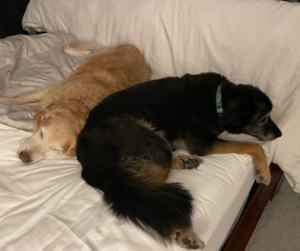Michael Baugh CDBC CPDT-KSA
I teach several techniques related to aggressive dog training. They all help. However, none is as essential as preventing your dog from being triggered. Trainers call this managing your dog’s environment or, simply, management. Some add “just” before the word “manage.” We can just manage the problem. I think this dimunitzation is a mistake. Controlling and preventing environmental triggers is key to your dog’s success.
Here’s an example. Our dog consistently barks and lunges at guests we invite into our home. If the dog is in another room or in the backyard, our dog does not see the guest. Barking and lunging does not occur. It’s tempting to discount this technique by saying we are avoiding the problem. I get that. The technical term is actually antecedent control. We are preventing the problem one occurrence at a time.
Let’s say we have a broken pipe in our home. Our home is flooding. The first and most important step is to turn off the water. We can’t fix a pipe with water gushing out. Eliminating our dog’s triggers is like turning off the water. It’s the first fix. Our other positive training interventions are analogous to repairing the broken pipe. We do these with the trigger absent, muted, far away, or otherwise controlled. Staying with the plumbing analogy, the water is still off.
Remember our dog who barks and lunges at guests? We’ve stopped triggering him with unexpected strangers. Good. Now we can teach him some relaxation and other coping skills. We can even begin letting him see people in our home under controlled, non-triggering circumstances. I call these “controlled exposures.” All the while, we maintain our promise to protect our dog from surprises and his own hair-trigger responses. When we aren’t training, we are managing his environment. This is how we ease our dog into a new skill set of calm, confident behavior.
(Video: Your Dog’s Behavior Thresholds)
I frequently ask clients how long it’s been since their dog’s last aggressive incident. The longer the duration, the better off we are. Our dog needs a low-stress environment to learn new skills and new emotional self-regulation. They also need people and places that are consistently safe and stress-free. We can relate to this. It’s hard to work on our own anxiety or depression when stimuli keep coming at us. Overbooked calendars, traffic, loud noises, toxic people, distressing news reports. Any of those can disrupt our mental wellness. Two or three can derail us. We need people who will give us a soft place to land, a place where we can exhale.
Be that person for your dog.
Avoid this common mistake. Stop testing your dog. Too often, we intentionally expose our dogs to things we know upset them. We might think we are helping him get used to it. Pause and think about that for a minute. Does flying in a helicopter with the door off help us get over our fear of heights? No, of course it doesn’t. It’s worth repeating. Stop testing your dog. Let’s keep our promise to protect and help him. Let’s provide that safe place where scary things never happen. Be your dog’s safe person. Commit and stay committed.
I received an email recently from a client I hadn’t seen in a long while. She’d hired me back when she and her partner moved in together. They were and still are very much in love. Each of them had a dog. And, the dogs didn’t like each other. They fought. You can imagine the strain that puts on a relationship. We love each other. We love our dogs. Something’s got to give, or so the saying goes.
“They’ve progressed well over time with patience and not rushing it,” the email read. My clients had kept the dogs separate and controlled the environment. When everyone was together, it was in thoughtful and controlled exposures. “That has provided a lot of peace and happiness in the house,” she went on. They stayed the course, trusted the process, and never tested. “…thank you very much for your help,” she wrote before telling me about their new puppy.
The email ended with a photo. I stared at it for a long time. Two dogs curled on a bed, their backs pressed one to the other. Maybe they didn’t love one another like their humans did. Maybe they did. We don’t get to know those secrets. But the photo made this clear enough. They were safe. They were home. And “home” meant each other.
Michael Baugh teaches dog training in Houston, Texas.

